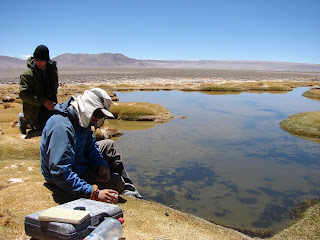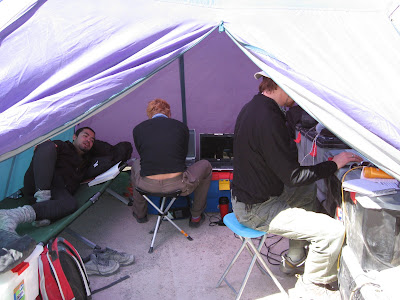 Image: Orongo Volcano. This shot was taken by Pete Polsgrove in August 2008. I did not have my camera on this run, so I had to dig into my Rapa Nui photo archives.
Image: Orongo Volcano. This shot was taken by Pete Polsgrove in August 2008. I did not have my camera on this run, so I had to dig into my Rapa Nui photo archives.Today was a really great day. Initially, we had planned to go surfing this morning. However, when we arrived at the beach, there were no waves. So, we decided to go for a run. After stopping by Alicia’s house and my hotel room to grab our gear, we ventured to the base of Orongo. Orongo (or Rano Kau) is the second largest volcano one the island. Our plan to run up and then down the volcano. It was high noon and near 100% humidity at this point. It was rather funny. As I am running up this volcano, I’m thinking this is not the right time of day for this, and about that time, Alicia’s said, “we should be doing this at six or eight in the morning." We both laughed and proceeded up hill.
This caldera of Rano Kau is absolutely breathtaking. There are literally a hundred freshwater lakes within this caldera. You can also peer through the lowest point of the caldera and into the Pacific Ocean.
 Image: Another view of Orongo. Credit: Pete Polsgrove.
Image: Another view of Orongo. Credit: Pete Polsgrove.After gazing into the volcano for sometime, we decided to tackle the down hill portion of our run. This was a blast for me. I haven’t ran down hill in a while, and I was really looking forward to opening up the legs and running hard. Once we were back to the jeep, Alicia said I usually jump into the ocean after this run. Looking around and noticing there were only cliff faces to be found, I agreed that a dip in the ocean would be great!
So, we walked down to the water and we jumped off a 30 foot cliff into the ocean. It was an amazing adrenalin rush.
Thereafter, we grabbed some lunch and then off to the caves. We had another day in the Maunga Hiva Hiva region.
There were a few leads that we discovered yesterday, that we wanted to pursue. However, we wanted to check out the tourist cave first. There is a large tourist cave in this region that I wanted to inspect. I determined this would be a good cave for biodiversity inventories because it has received so much human visitation. This cave has two major sections, one is northward toward the coast, the other southward. We went through the northern section first. There were some other leads near the coast that we wanted to inspect. The northern section is highly disturbed and the soil of the cave floor is highly compacted. I would be surprised if much life exists in this cave.
 Image: Alicia Ika.
Image: Alicia Ika.Once we arrived at the northern most entrance, we walked further northward to some large guava trees. This was good for two reasons – one fresh guavas, two it was a collapse pit with a cave within. After completely gorging ourselves on ripe guavas, and debating about exactly how many guavas does one need to eat to get really sick, we decided to go into the cave. This cave has been highly modified and extensively used by ranchers. The locals had pumped water out of this cave and filled two troughs for horses – one was within the collapse pit, the other was on the rim of the pit.
Interestingly, this cave contained millipedes, spring tails and nematodes. We will be coming back to collect at this cave in a few days.
Once done, we returned to the tourist cave. We wanted to explore the southern extent of the cave. This section contains an avocado tree that had grown up out of a sky light. It had fought for every ray of sunlight for many, many years before growing about 20 feet high and breaching the surface through the cave. Once we arrived at the tree, Alicia and I decided to climb it to get out. This was a lot of fun and a little challenging as well.
 Image: A majestic veiw from one of the many cliff caves we investigated during this expedition.
Image: A majestic veiw from one of the many cliff caves we investigated during this expedition.

























